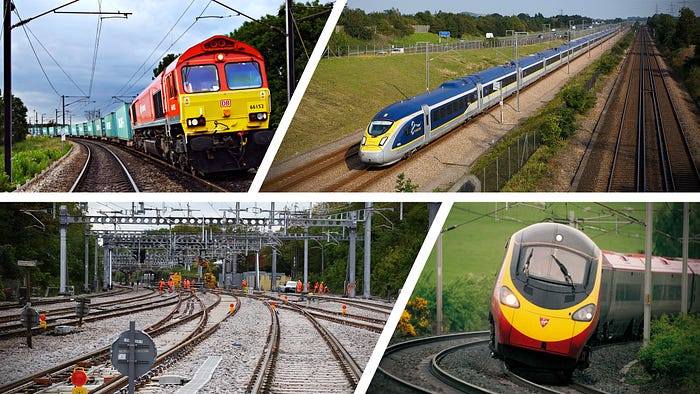High Speed Two and the need for speed

In the first of a two part look at High Speed Two, GARETH DENNIS explains why a reduction in fares or an improvement in urban connectivity is impossible without a step-change in network capacity
A version of this article also appeared in Issue 858 (1 August 2018) of RAIL magazine.
Despite having largely completed its journey through parliament and with construction having started in earnest at Euston station, High Speed 2 (the UK’s new high speed rail line) continues to stir up debate. Why it is being prioritised over other corridors such as those in the north or south west? Does it follow the best route? Is it necessary at all?
The GB rail network is one of the most densely trafficked in Europe, even before you consider freight. On key routes, existing lines are already reaching capacity; the recent timetable omnishambles is proof of how interconnected the whole system is. With rail’s modal share having doubled since the 1990s, it is small wonder that it is now creaking under the strain. Significant jumps in passenger numbers would result in a dramatic drop in reliability and a disproportionate hike in operating costs.
To facilitate even a modest modal shift in favour of the train, we need a step-change in the railway’s capacity to move people and things around nationally.
The capacity conundrum
People often talk about the possibility of upgrading existing lines with new signalling, improved linespeeds or even extra tracks. Whilst these may be useful interventions in isolation, none can provide a significant regional or national improvement in capacity. Major upgrades to the existing infrastructure are excruciatingly complex. To say that it is difficult to accurately estimate costs and timescales would be an understatement.
The highest capacity lines are the ones that operate the rolling stock with the closest performance parameters (acceleration, deceleration and top speed). If the difference between top speeds is minimised, then the trains can get nice and close to one another and you can run more of them per hour.
The trouble is, the British rail network represents the opposite of this situation.
Slow freight and stopping trains intermingle with regional medium-speed services. Trying to negotiate its way through this traffic is the most effective capacity-killer of all: the long distance, high speed service (LDHSS). High speeds and limited stops mean these trains require a large interval or “headway” (the distance between trains), with other services being pushed out of the way. Route capacity suffers.
The solution is to extricate these fast trains from the rest of the railway: in other words, the segregation of LDHSS.

The hub/rich club model
Consider the major areas of population and economic output as a series of urban “hubs”. These are the clusters of cities that are connected by less than an hour’s travel and have a population greater than one million people.
When thinking of a rail network, we can consider connectivity on two levels: intra-hub (travel within hubs) and inter-hub (travel between hubs). Combining these two levels of connectivity gives us a map that starts looking like the current GB railway network…
It’s easy to see that there is a conflict between the intra-hub and inter-hub services through the Midlands and the North. At the same time, the north-south corridor gets busier as you get closer to London, with the southern-most section carrying all north-south inter-hub traffic from the Midlands, the North and Scotland.
The inter-hub routes from London to the south coast and from London to Bristol and South Wales don’t carry traffic from other hubs. They also don’t have to carry intra-hub and inter-hub traffic at the same time. These corridors are therefore less critical to overall capacity.
High Speed 2’s route aims to solve both the intra-hub and inter-hub capacity constraints between the North, the Midlands and London by providing a new line carrying high speed passenger trains on the north-south rail corridor.
By segregating LDHSS onto their own lines, capacity is created for more intra-hub services (as well as freight and local trains). The existing urban and regional networks then feed passengers onto High Speed 2.
In network science this represents a “hub/rich club” model, where high flow rates exist between hubs that are themselves fed by lots of interconnecting pathways.
HS2 Phase 1 covers the southernmost corridor that carries all inter-hub traffic from north of London. This section will have the greatest capacity, comprising what is effectively a straight line from London to Birmingham. HS2 Phase 2 provides two “legs” to separate intra-hub/inter-hub services across the North and inter-hub traffic from Scotland.
But why must it be high speed?
The reason for constructing this new line to high speed specifications is simple: to incentivise the diversion of LDHSS from the three major north-south main lines (the West Coast Main Line, the Midland Main Line and the East Coast Main Line) onto the new segregated line, journey times from the northern-most destinations must be at least as good as the current service.
Essentially, High Speed 2 gives us six lines for the price of two.

High speed rail isn’t really about high speed at all
Oddly enough, high speed passenger services only form a small part of what the UK’s new high speed rail line will deliver… In combination with upgrades to intra-hub connectivity, it is the freed capacity on the rest of the network that will have the greatest benefit for passenger and freight transport.
Yet the story doesn’t seem to be getting through. As engineers, it is not just our duty to create new infrastructure, it is also our duty to communicate its purpose. Helping the British public to get behind High Speed 2 must be a priority for our industry if we are to truly make this megaproject a success.
